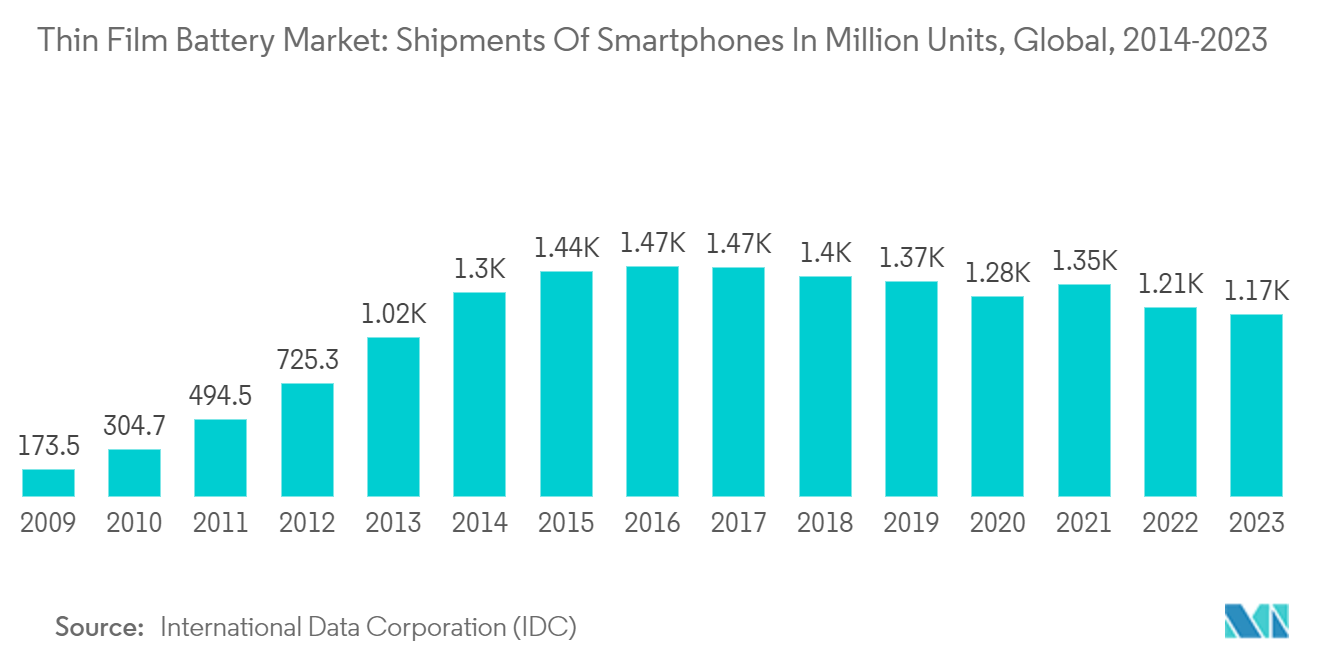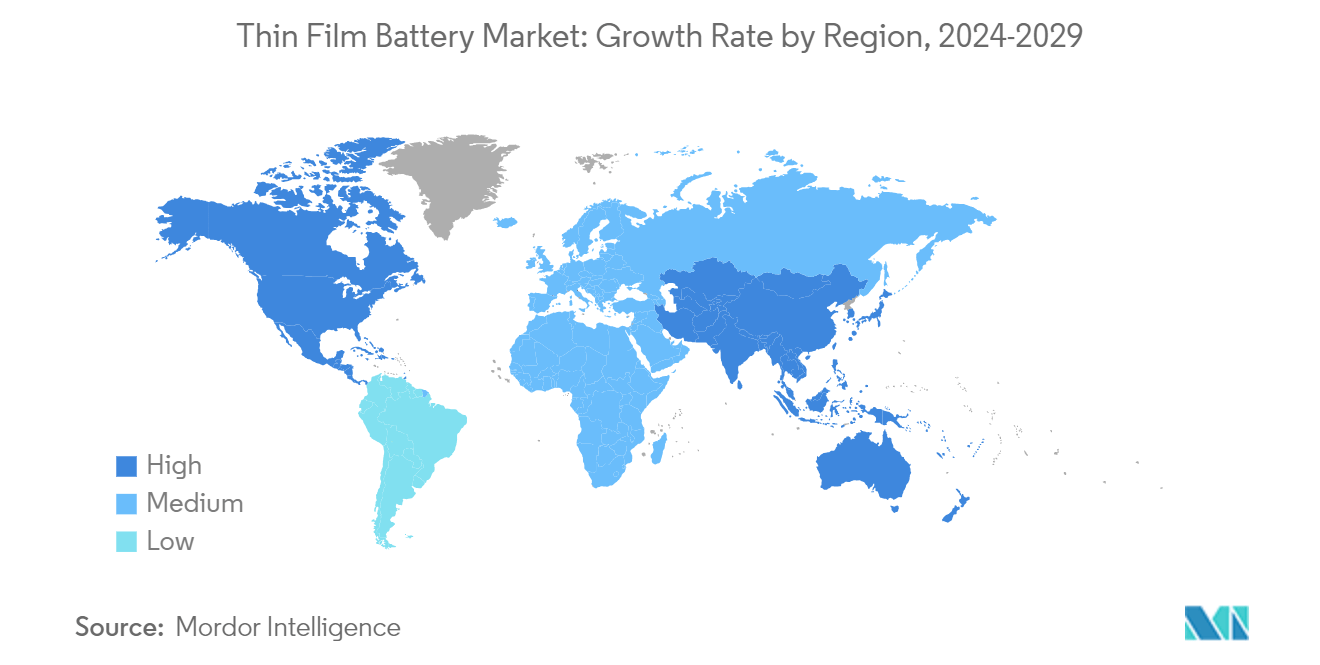Market Trends of Thin Film Battery Industry
Consumer Electronics Segment to Dominate the Market
- Consumer electronics are anticipated to dominate the thin film battery market due to the increasing demand for smaller, lighter, and more efficient power sources in this sector. The proliferation of portable devices, such as smartphones, wearables, and tablets, has led to a burgeoning need for compact and flexible energy solutions.
- Moreover, with the increased shipments of consumer electronics, such as smart watches, wearable health monitoring devices, and smart glasses, portable batteries are expected to witness tremendous growth globally during the forecast period. According to International Data Corporation (IDC), smartphone Shipments across the globe increased 5.7 times compared to 2009.
- The tendency toward miniaturization in consumer electronics has resulted in a need for efficient power sources that can adapt to diverse characteristics and design requirements. Thin-film batteries, with their thinness, flexibility, and customizable shapes, perfectly meet this demand, facilitating their seamless integration into a comprehensive array of consumer electronic gadgets.
- For instance, in August 2023, a group of scientists from German and British universities announced that they had completed the development of T-Nb2O5 thin films, facilitating the accelerated movement of Li-ion, a noteworthy stride forward. This breakthrough holds the potential for enhanced batteries and progress in computing and lighting, signifying a considerable advancement in consumer electronics. Forecasts suggest a boost in battery energy density and recharge cycles, offering substantial prospects in the consumer electronics sector.
- Moreover, the evolving landscape of consumer preferences emphasizes convenience, longer device lifespans, and a desire for more sustainable energy solutions. Thin film batteries, with their potential for improved energy density and longer cycle life, meet these consumer demands by offering extended device usage and reduced environmental impact compared to traditional bulky batteries.
- The market's dominance by consumer electronics is also influenced by the expanding global penetration of these devices, especially in emerging economies. The increasing consumer base in these regions demands devices that are not only affordable but also equipped with reliable and durable power sources.
- Therefore, as per the points mentioned above, the consumer electronics market segment is expected to dominate the market during the forecast period.

Asia-Pacific to be the Fastest-Growing Region
- The Asia-Pacific region is poised to witness remarkable growth in the thin film battery market, attributed to various factors contributing to its expanding dominance in this sector. One of the primary driving forces is the burgeoning consumer electronics industry in countries like China, Japan, South Korea, and India.
- Thin film batteries, which contain ceramic electrolytes, are known as ceramic batteries. Ceramic materials have high melting points due to their strong covalent bonds, which allows these batteries to operate at very high temperatures. Using ceramic batteries in electric vehicles has several advantages compared to other battery technology. According to IEA, the total electric car sales reached more than 10 million in 2022, led by the Asia Pacific region. A total of 14% of all new cars sold were electric in 2022, up from around 9% in 2021 and less than 5% in 2020.
- Wearable devices will likely emerge as significant consumers of thin film batteries and are witnessing substantial growth in China. For instance, according to the International Data Corporation (IDC), China's shipments of wearable devices went up 7.5% year on year to reach 34.7 million units in the third quarter (Q3) of 2023. In July-September, China shipped over 19.24 million units of ear-worn devices, an expansion of 9.8% year on year.
- Furthermore, the rapid industrialization and technological advancements in the Asia Pacific region have paved the way for substantial innovations and investments in research and development activities related to thin film battery technologies.
- Wearable devices have been experiencing considerable adoption over the past few years in India, and it is anticipated they will remain an attractive potential end-use application industry. For instance, according to the International Data Corporation (IDC), the Indian wearable market saw a 34% growth, recording 134.2 million units in 2023. The average selling price of wearables dropped over 15% to USD 21.2. This scenario will likely increase the adoption of such devices and remain an attractive market for many flexible small batteries.
- In April 2023, the Government of India approved the National Medical Devices Policy, 2023, which will likely facilitate the growth of the medical device sector to meet the public health objectives of access, quality, affordability, and innovation. Further, this sector is expected to realize its potential, with strategies for developing an enabling ecosystem for manufacturing, focusing on creating a robust regulatory framework and innovation and offering support through training and capacity-building programs. Encouraging domestic investments and medical device production complements the Indian government’s Atmanirbhar Bharat and Make in India programs.
- For instance, the Japanese government revealed in February 2023 a battery strategy budget totaling USD 2.55 billion designated for the research and development of new battery technologies, encompassing diverse types such as all-solid-state lithium batteries, thin film batteries, and a range of emerging battery technologies. This initiative is anticipated to bolster Japan's position in the realm of battery technology.
- Moreover, the Asia-Pacific region's strong manufacturing capabilities, coupled with a favorable regulatory environment and a robust supply chain infrastructure, position it as a hub for thin-film battery production. Cost-effective manufacturing processes, increasing investments in technological advancements, and a growing emphasis on environmentally friendly energy sources reinforce the region's foothold in the thin-film battery market.
- Therefore, as per the points mentioned above, the Asia-Pacific Region is expected to witness significant growth during the forecast period.

